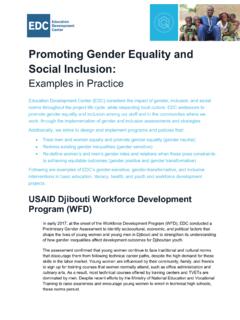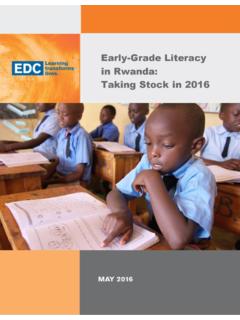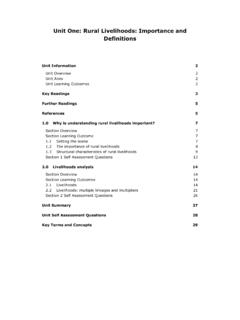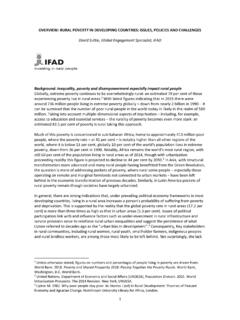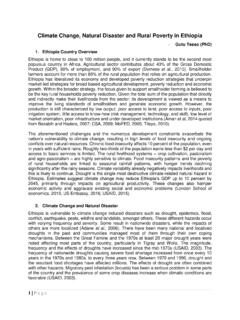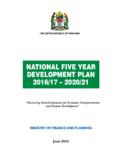Transcription of YOUTH LIVELIHOODS DEVELOPMENT PROGRAM GUIDE
1 | iYouth LIVELIHOODS DEVELOPMENT PROGRAM GuideProject Contacts:Barry SternDirector, EQUIP3 Education DEVELOPMENT Center, IgnatowskiEQUIP3 CTOUSAID/ EGAT/ Office of 2008 Written By: David James-WilsonYOUTH LIVELIHOODS DEVELOPMENT PROGRAM GUIDE | iYouth LIVELIHOODS DEVELOPMENT PROGRAM GuideTABLE OF CONTENTSACKNOWLEDGEMENTS LIST OF ACRONYMS EXECUTIVE SUMMARY INTRODUCTION A. A COMMON LANGUAGE FOR YOUTH LIVELIHOOD PROGRAMS B. CONCEPTUAL FRAMEWORK FOR YOUTH LIVELIHOOD PROGRAMS Most YOUTH Are Economically Active Young People s Economic Activities Are Linked To Household Livelihood Households Are Actively Engaged In Planning For YOUTH Livelihood YOUTH Must Often Balance Education With Work Livelihood Programming Should Reflect The Marketplace And Build From Existing Assets And Activities Livelihood Is The Core Driver Of Positive YOUTH DEVELOPMENT Outcomes The YOUTH Cohort Is Diverse YOUTH Livelihood Programs Should Be Cross-Sectoral And
2 Track Both Livelihood-Specific And Cross-Cutting Outcomes And Impacts C. DESIGNING EFFECTIVE YOUTH LIVELIHOOD STRATEGIES Resources To Strengthen YOUTH Livelihood Capacities Designing Strategies That Build YOUTH LIVELIHOODS Strategies To Help YOUTH Develop Human Capital Strategies To Help YOUTH Develop Financial Capital Strategies To Help YOUTH Develop Social Capital Strategies To Help YOUTH Acquire Physical Capital Achieving Sector-Specific PROGRAM Goals Through YOUTH Livelihood Capacity-Building Activities D. ADDITIONAL INFORMATION AND RESOURCES CONCLUSION REFERENCES ABOUT EQUIP3iiiiiiv1 466778101112121717181819222526 28 29 3032ii | YOUTH LIVELIHOODS DEVELOPMENT PROGRAM GuideThis GUIDE has benefited enormously from the contributions of a number of reviewers whose insights, poignant critiques, and practi-cal examples have made this a much-improved final product.
3 Barry Stern and Paul Sully were Education DEVELOPMENT Center Directors of the EQUIP3 project under which the GUIDE was pro-duced. Clare Ignatowski was the USAID Cogni-zant Technical Office for this work and provided overall guidance and detailed reviews of drafts. Other reviewers from USAID were Amanda Eichelkraut, Ishrat Husain, Anicca Jansen, Cheryl Kim, Mary Hughes Knox, Suezan Lee, Allyn Moushey, John Williamson, and Jason author of this GUIDE would also like to thank the many staff at EQUIP3 who have con-tributed to improving the content, presentation and overall readability of this GUIDE .
4 They in-clude: Ann Hershkowitz, Melanie Beauvy, Nancy Devine, Caroline Fawcett, Paul Sully, Ron Israel, Cornelia Janke, Nancy Meaker and Erin , this author owes a debt of gratitude to Joan Hall and the team at Making Cents, Inc. for case examples drawn from the 2007 YOUTH Micro-enterprise Conference, and to Barry Stern for his steady hand as the ultimate editor of this document. David James-WilsonACKNOWLEDGEMENTS| iiiYouth LIVELIHOODS DEVELOPMENT PROGRAM GuideARCAREUBCYFCEDEACGAPDCOFEDCEFAELAEQ UIP3 ILOIPMIRCIRINIZALCEPM&EMFINGOOSIS&OSCSIS KITKLUN-DESAUNESCOUSAIDUSGYBAYBIYENYSOA merican Refugee CommitteeAfghanistan Research and Evaluation UnitBalkan Children and YOUTH FoundationCenter for the DEVELOPMENT of Alternative EducationThe Consultative Group to Help the PoorDisplaced Children and Orphans FundEducation DEVELOPMENT CenterEducation For AllEmployment and LIVELIHOODS for AdolescentsEducation Quality Improvement PROGRAM 3 International
5 Labor OrganizationIntegrated Pest ManagementInternational Rescue CommitteeIntegrated Regional Information NetworksInstitute for the Study of LaborLiteracy and Community Empowerment ProgramMonitoring and EvaluationMicrofinance InstitutionNon-governmental OrganizationOpen Societies InstituteStrategic and Operational PlanSave the ChildrenSearch InstituteStreet Kids InternationalThe Kids LeagueUnited Nations Department of Economic and Social AffairsUnited Nations Educational, Scientific and Cultural OrganizationUnited States Agency for International DevelopmentUnited States GovernmentYouth Business AlbaniaYouth Business InternationalYouth Employment NetworkYouth-Serving OrganizationLIST OF ACRONYMSiv | YOUTH LIVELIHOODS DEVELOPMENT PROGRAM GuideImagine a country where half of the YOUTH is neither in school nor employed in the formal economy , where private sector jobs leading to careers are scarce, where YOUTH unemployment rates in the formal economy exceed 50 percent.
6 Where educational opportunities beyond the fourth grade cannot be accessed by half the population, where there is a clear mismatch between the skills provided by schools and uni-versities and the ones that employers want, and where the growth of the country s economy has trouble keeping up with the rapid growth of its YOUTH population. Such would describe the plight of today s YOUTH in many developing countries, particularly those in countries emerg-ing from several decades international agencies have been supporting education and training pro-grams that prepare YOUTH for the workforce and higher levels of education.
7 Programs are based on the assumption that the private sector is growing and has jobs for qualified applicants. But suppose jobs are scarce and employers are reluctant to invest where literacy rates are low? What good are workforce DEVELOPMENT pro-grams when there are no jobs? And if workforce DEVELOPMENT can benefit only a small percent-age of YOUTH because of dire economic realities, what can be done to improve the well-being of the rest and give them hope? In response to this dilemma, USAID and other donor agencies have become increasingly interested in supplementing workforce develop-ment strategies with what is called livelihood DEVELOPMENT , especially for young people aged 15 24 from marginalized backgrounds.
8 Donor agencies increasingly recognize that millions of young people working in the informal sector are finding ways to eke out a living and make something from very little in some cases, something from almost nothing. And they take whatever paths are available to them, pro-social or otherwise. Acknowledging this reality, agen-cies are learning that successful strategies must help YOUTH where they are until they can break into the formal economy and that interventions should assist and accelerate this process while improving the short-term well-being of YOUTH and their agencies, non-governmental organiza-tions (NGOs), host country governments, and civil society are also coming to realize that YOUTH can and should be key actors in the strengthening, rebuilding, and transformation of their nations.
9 When appropriately engaged and adequately prepared for roles in the worlds of work, family life, and civil society, YOUTH can be definite assets for community DEVELOPMENT . However, when governments and communities disregard the huge numbers of YOUTH with mini-mal attachment to the formal sector, YOUTH can also become a profoundly de-stabilizing force. Specifically, the absence of livelihood develop-ment opportunities for YOUTH can impede a nation s DEVELOPMENT in the form of increased crime, violence, poor health, disease, extrem-ism, and both social and political instability.
10 Thus, the presence of livelihood DEVELOPMENT (to complement workforce DEVELOPMENT ) is a strategic necessity for national DEVELOPMENT , especially when delivered in careful coordina-tion with traditional investments in health, education, democracy and governance, and economic growth FRAMEWORKS uccessful livelihood DEVELOPMENT programs reflect actual YOUTH realities and respond to EXECUTIVE SUMMARY| vYouth LIVELIHOODS DEVELOPMENT PROGRAM Guidethe existing goals, plans and strategies of young people themselves and their community sup-porters (especially at the household and ex-tended family levels).

